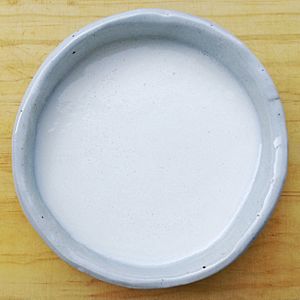Tarak-juk facts for kids
 |
|
| Alternative names | Uyu-juk, milk porridge |
|---|---|
| Type | Juk |
| Place of origin | Korea |
| Associated national cuisine | Korean cuisine |
| Serving temperature | Warm |
| Main ingredients | Milk, ground rice |
| Korean name | |
| Hangul |
타락죽
|
|---|---|
| Hanja |
駝酪粥
|
| Revised Romanization | tarak-juk |
| McCune–Reischauer | t'arak-chuk |
| IPA | [tʰa.ɾak̚.t͈ɕuk̚] |
| Hangul |
우유죽
|
| Hanja |
牛乳粥
|
| Revised Romanization | uyu-juk |
| McCune–Reischauer | uyu-chuk |
| IPA | [u.ju.dʑuk̚] |
Tarak-juk (Korean: 타락죽) is a special Korean porridge. It is also known as uyu-juk (Korean: 우유죽) or milk porridge. This creamy dish is made from milk and ground rice. It was a very important food in the Korean royal court cuisine. Important people like yangban (scholarly officials) also enjoyed it.
Contents
What's in a Name?
The name tarak-juk comes from two Korean words. The first part, tarak, means "dairy." The second part, juk, means "porridge." So, tarak-juk literally means "dairy porridge."
The word tarak has an interesting history. It comes from words in the Mongolian and Old Turkic languages. These words, like taraq, mean "cheese." This shows that Korean dairy foods were influenced by customs from Central Asia, especially Mongolia. People there often made products from fermented milk.
A Look Back in Time
The story of tarak-juk goes way back in Korean history. People started drinking milk a long time ago.
Milk in Ancient Korea
During the Kingdom of Goryeo (918–1392), there was a special office called Yuu-so. This office was in charge of dairy cows. Important people, called nobles, ate a type of cheese called nakso. However, dairy cows were not very common. Milk was usually only available after a cow had a baby. Also, milk had to be fresh because it could not be carried far. Because of this, milk was seen as a special food. It was often given for special events or to help people recover from illness.
Royal Porridge in Joseon
During the Joseon era (1392–1897), the dairy cow office moved. It became a royal farm on Mount Naksan, near Seoul. Its new name was Tarak-saek, which means "dairy department."
Royal physicians (doctors for the king) were in charge of getting milk. They also made tarak-juk to give to the king. This special porridge was offered to the royal court every year. It was served from the tenth lunar month to the first month of the next year. The Hall of Senior Officials also gave tarak-juk to older officials. You can find recipes for tarak-juk in old Joseon books. Some of these books include Revised and Augmented Farm Management and the Women's Encyclopedia.
How It's Made
Making tarak-juk involves a few steps to get its creamy texture.
First, glutinous rice is soaked in water. Then, it is ground using a millstone. The ground rice is then sieved (strained) and left to settle. The thick part that settles at the bottom is called muri.
Next, this muri is boiled. While it boils, milk is slowly added. It is cooked over a low heat, and stirred all the time. This constant stirring makes sure the porridge is smooth and creamy. Finally, salt is added to taste. If you want it sweeter, you can also add honey.
An old book, the Women's Encyclopedia, suggests a certain amount of milk and muri. It says the ratio should be about 1 part milk to 0.8 parts muri. But it also says you can change this to fit your taste. The book advises that you should not use more muri than milk.
See also
 In Spanish: Tarakjuk para niños
In Spanish: Tarakjuk para niños

